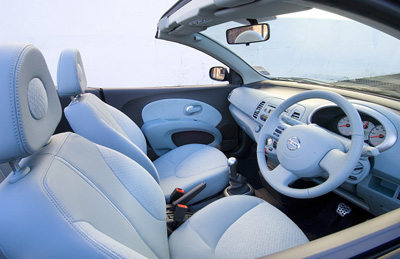Review
Nissan quotes an expected European market this year of 150,000 for compact convertibles, of which 70% will be retractable hardtops.
So having a strong contender in this sector will give retailers a great weapon in the tussle for sales. The manufacturer is predicting a good percentage of conquest sales and half of all customers to be within the 26-45 year old age group.
The clear message from existing convertible owners canvassed by Nissan was that roof quality and body rigidity were the most common causes for complaint.
Nissan has done its homework, and with a £95m investment behind the C+C’s production, it has high hopes for the car.
Despite gaining a fairly sizable rump over its fixed roof sibling, the C+C’s looks are still firmly rooted at the cutesy end of the spectrum. However, its lines definitely work best with the roof down. And it is this Karmann-designed two-piece roof that is really at the heart of the new car.
Complete with a C-View integral glass panel, Nissan has coined the phrase ‘Auto-Open Roof’ as the side windows and all roof-raising functions are operated with one button.
This simplicity certainly marks the C+C out from competitors such as the Mitsubishi Colt CZC, which needs its two roof catches manually releasing.
Another neat touch is that the roof can be raised or lowered at speeds of up to 3mph, so if you’re in traffic and start a lowering or raising manoeuvre, you can finish it off without having to remain at a stand still.
Conventionally, the roof would be preassembled by a supplier and shipped to the factory.
Nissan say that such are the fine build tolerances involved with the C+C, Karmann has established a production facility within the manufacturer’s Sunderland plant. The C+C is available in either 1.4-litre Urbis, or 1.6-litre Sport or Essenza specification.
The Essenza gains automatic air-conditioning, heated leather seats, ESP (Electronic Stability Control) and Nissan’s intelligent key feature over the Urbis or Sport models.
Build quality is good and the work Nissan has put into reinforcing the C+C over the standard Micra is clear.
In fact, despite the visual similarities between the two models, virtually everything visible from the A-pillar back is unique to the new car.
Launched in December last year, 1,431 examples have been sold year to date, although no year-end target is being revealed by the manufacturer.
With a balmy summer predicted by those in the know, dealers should be enjoying a lot of interest in Nissan’s “chic, elegant and modern” addition to the Micra family.

Behind the wheel
The C+C didn’t set out to offer the ultimate driving experience, majoring instead on fashionable town driving with a heavy female bias to its buyer profile.
Even so, the combination of overly light steering and a seating position that is just too high have conspired to make driving Nissan’s little sun seeker an uninvolving experience.
Push beyond what feels like the car’s natural limits and the C+C proves it has more road holding prowess than at first appears. However, this takes a leap of faith that most buyers will be unwilling to take.
That said, the engine in our 1.6-litre Essenza was a great unit, free-revving and willing. But in the final analysis, the car undoubtedly feels most at home posing at sedate speeds.
Prices: £13,250-16,150
Engines: 1.4-litre 16v, 1.6-litre 16v petrol
Performance: 1.4: 0-62mph 12sec, top speed 109mph; 1.6: 0-62mph 10sec, top speed 119mph
Transmission: Five speed manual, four speed automatic
Efficiency: 42.2mpg-42.8mpg; 158g/km-160g/km CO2
CAP RV 3yr/30k: Essanza: £6,075, 40%
Rivals: Colt CZC, Vauxhall Tigra, Peugeot 207cc
Strength: Slick roof operation, build quality
Weakness: Seat height, steering weight
Opportunity: Take a slice of the 150,000-strong European convertible market
Threat: Growing number of rivals
USP: Nissan reliability packaged in cutesy/chic boulevard cruiser
Factsheet
No information available.













